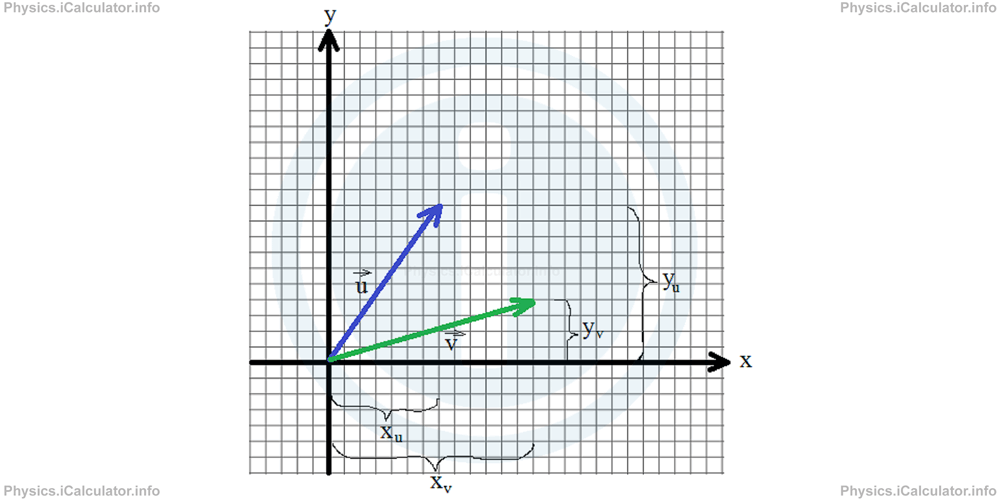Menu
Physics Lesson 2.4.2 - Dot (scalar) product applications in Physics
Please provide a rating, it takes seconds and helps us to keep this resource free for all to use
Welcome to our Physics lesson on Dot (scalar) product applications in Physics, this is the second lesson of our suite of physics lessons covering the topic of Dot (Scalar) Product of Two Vectors, you can find links to the other lessons within this tutorial and access additional physics learning resources below this lesson.
Dot (scalar) product applications in Physics
There are many applications of dot (scalar) product of two vectors in Physics. Below, we will mention only a few of them.
1. Work as a dot product of Force and Displacement.
We have discussed earlier (in Introduction) this point. If you multiply in scalar mode the force exerted by an object and the displacement of the object due to the action of this force, the result will be a scalar quantity known as Work and measured in Joules. It is meaningless to say "the work done by the force F is 300 J due East" for example. We simply say "the work done by the force F is 300 J" as work is a quantity related to the change in energy of a system (see the article 5.1 "Work and Energy" for more detail); it does not involve any direction.
2. Power as a dot product of Force and Velocity.
We discussed this point earlier in the solved example. If we multiply in scalar mode the two vector quantities, Force and Displacement, we obtain a scalar result that is Power. It does not involve any direction as well.
3. The angle between two forces acting on the same object.
Let's consider again the solved example in the previous section (let's take the abovementioned vectors as force vectors and the units as newtons).

We found the dot product of vectors u⃗ and v⃗ and it was 131 units. Now, let's calculate the magnitudes of each vector. From the article "Vectors and Scalars in Physics" we know that
and
Therefore, we obtain for the angle between u⃗ and v⃗
= 131/√149 ∙ √185
= 131/166
= 0.789
Therefore, the angle between the two vectors u⃗ and v⃗ is cos-1 0.789 = 37.890.
This result was obtained much easier than if we used the (long) method described in the previous section.
4. Kinetic Energy as a dot product of linear momentum and velocity.
Kinetic Energy of a moving object (a scalar quantity measured in Joules like Work) is calculated through the equation
where m is the mass of the object and v⃗ is its velocity (look at the article "Kinetic Energy. Work-Kinetic Energy Theorem" for more info regarding this concept).
However, since the linear momentum of a moving object is p⃗ = m ∙ v⃗ (look at the article "Momentum and Impulse" for more info regarding this concept), we obtain for the kinetic energy KE
= 1/2 ∙ p⃗ ∙ v⃗
Therefore, Kinetic Energy can be expressed as the dot product of two vectors, p⃗ and v⃗ multiplied by a constant 1/2 (which only changes the result; it does not breaks the abovementioned rule).
These were some examples showing the most important applications of dot product in Physics.
You have reach the end of Physics lesson 2.4.2 Dot (scalar) product applications in Physics. There are 2 lessons in this physics tutorial covering Dot (Scalar) Product of Two Vectors, you can access all the lessons from this tutorial below.
More Dot (Scalar) Product of Two Vectors Lessons and Learning Resources
Whats next?
Enjoy the "Dot (scalar) product applications in Physics" physics lesson? People who liked the "Dot (Scalar) Product of Two Vectors lesson found the following resources useful:
- Application Feedback. Helps other - Leave a rating for this application (see below)
- Vectors and Scalars Physics tutorial: Dot (Scalar) Product of Two Vectors. Read the Dot (Scalar) Product of Two Vectors physics tutorial and build your physics knowledge of Vectors and Scalars
- Vectors and Scalars Video tutorial: Dot (Scalar) Product of Two Vectors. Watch or listen to the Dot (Scalar) Product of Two Vectors video tutorial, a useful way to help you revise when travelling to and from school/college
- Vectors and Scalars Revision Notes: Dot (Scalar) Product of Two Vectors. Print the notes so you can revise the key points covered in the physics tutorial for Dot (Scalar) Product of Two Vectors
- Vectors and Scalars Practice Questions: Dot (Scalar) Product of Two Vectors. Test and improve your knowledge of Dot (Scalar) Product of Two Vectors with example questins and answers
- Check your calculations for Vectors and Scalars questions with our excellent Vectors and Scalars calculators which contain full equations and calculations clearly displayed line by line. See the Vectors and Scalars Calculators by iCalculator™ below.
- Continuing learning vectors and scalars - read our next physics tutorial: Vector Product of Two Vectors
Help others Learning Physics just like you
Please provide a rating, it takes seconds and helps us to keep this resource free for all to use
We hope you found this Physics lesson "Dot (Scalar) Product of Two Vectors" useful. If you did it would be great if you could spare the time to rate this physics lesson (simply click on the number of stars that match your assessment of this physics learning aide) and/or share on social media, this helps us identify popular tutorials and calculators and expand our free learning resources to support our users around the world have free access to expand their knowledge of physics and other disciplines.